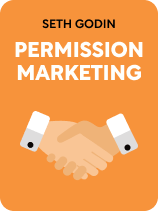

This article is an excerpt from the Shortform book guide to "Permission Marketing" by Seth Godin. Shortform has the world's best summaries and analyses of books you should be reading.
Like this article? Sign up for a free trial here.
Do you find a lot of advertising intrusive? Do you want to market your product or service without annoying prospective customers?
Often, disruptive advertisements can feel more obnoxious than persuasive. In Permission Marketing, Seth Godin says there’s a better way for brands to get the attention of potential customers.
Keep reading for an overview of Permission Marketing, which shows you how to create marketing that customers actually ask to see.
Overview of Permission Marketing by Seth Godin
Think back to the last time you were annoyed by advertising—perhaps you had to sit through an interminable series of TV commercials in the middle of a football game or an unskippable 30-second spot on YouTube. But, is this disruptive advertising the most effective way for these brands to get their message across?
In Permission Marketing, Seth Godin says the answer is No; There’s a better way for brands to get the attention of potential customers. Instead of resorting to Interruption Marketing that consumers are forced to see, it’s possible to create advertising that consumers ask to see. By doing so, you can build a loyal customer base at a fraction of the cost of a traditional marketing campaign.
Godin is an entrepreneur and author of 20 best-selling books on marketing, leadership, and creativity. Although he published Permission Marketing back in 1999, its core concepts are arguably even more relevant this far into the Internet Age. As you learn about permission marketing techniques, you may be surprised to notice how many brands around you employ them.
(Shortform note: Since Godin coined the term “permission marketing” in this book, it’s grown in popularity and is still commonly used among marketers today. By emphasizing permission, the term is distinct from the similar term “one-to-one marketing” (often used to describe marketing techniques based on personal interactions between marketers and customers). Permission marketing reflects Godin’s belief that a personal relationship between business and customer is only durable when it’s reciprocal. The term “one-to-one marketing” predates Godin’s book, and the concept may have even inspired him to write it, as the authors of the influential marketing book The One to One Future were his mentors.)
We’ll begin by discussing the outdated 20th-century form of marketing: Interruption Marketing. We’ll note the conditions that led to its rise and describe the changing conditions that cause it to fail today. Next, we’ll define permission marketing and explain why it’s so profitable in today’s competitive landscape. Then, we’ll outline the mindset required to be an effective permission marketer. Finally, we’ll describe the specific steps you can take to profit from a permission marketing campaign.
The Old Way: Grab Attention With Interruption Marketing
Since the turn of the 20th century, the dominant form of marketing has been what Godin calls “Interruption Marketing.” This type of advertising attempts to pull consumers’ attention away from what they want to spend it on—for instance, a commercial might break the spell of a riveting TV show, and a billboard on the side of the road might interrupt a gorgeous view.
Godin explains that Interruption Marketing rose to prominence once companies could easily serve customers that didn’t live nearby. The assembly line allowed companies to cheaply mass-produce consumer goods, and automobiles allowed them to reliably distribute those goods to a wider customer base than ever before. These companies used mass media channels like radio, television, and magazines to create public demand for the name-brand goods they now produced and transported.
Interruption Marketing was profitable because its repeated intrusions successfully built consumer trust, according to Godin. Consumers who encountered enough advertisements from the same brand came to believe that the brand was popular and reliable. This led them to choose familiar brands whenever they were available, and due to modernized production and distribution, big brands became always available.
Interruption Marketing Is Less Successful Today
Although many major 20th-century corporations owe their success to Interruption Marketing, there are three main reasons why the practice is far less profitable today.
Reason #1: There Are Too Many Advertisements
First, Godin asserts that the world is oversaturated with advertisements. Once people discovered how profitable Interruption Marketing was, every major company started doing it. Consequently, there are far more brands competing today than in the early 20th century. Because there are so many advertisements fighting for our time and attention, consumers have learned to ignore the majority of branded messages they see to avoid getting overwhelmed.
Reason #2: We Have More Ways to Consume Media
Second, Interruption Marketing fails because consumers today have far more ways to consume media, argues Godin. During the rise of television, as more channels became available, fewer viewers tuned in to each one. This meant that every advertisement running on those channels reached fewer consumers and won fewer sales. The rise of the Internet fragmented consumers’ attention even more—modern users have countless options when looking for something online, and placing an advertisement on a single website will reach far fewer people than it would have through mass media in the 20th century.
Reason #3: Most Brands Are Good Enough
Third, Godin contends that Interruption Marketing fails because the average quality of consumer goods rose over time and hit a plateau. Competing brands all successfully accomplish what the consumer needs them to, and they do so almost equally well. Because all available options are good enough, consumers are content with sticking to whatever brand they regularly buy. They’re not interested in hearing what other brands can offer them and are unreceptive to Interruption Marketing.
The New Way: Building Relationships Through Permission Marketing
Now that we’ve covered what Interruption Marketing is and why it fails, let’s take a look at the alternative approach. Here, we’ll first define permission marketing. Then, we’ll explain why it’s so much more profitable than Interruption Marketing in today’s brand-saturated market.
What Is Permission Marketing?
Permission marketing involves sending advertising material directly to individual consumers after they request it, explains Godin. Instead of grabbing consumers’ attention while they’re doing something else, promotional material sent through permission marketing is available whenever they want to pay attention to it.
Permission marketing is the approach small local businesses used before the rise of Interruption Marketing. Consumers became personally familiar with the people who ran the businesses near them. If consumers thought they might need something, they would search out a seller and ask them about it directly, and the seller would gladly help. Today, Godin asserts that the internet makes permission marketing more scalable and profitable than ever before, as you can use email to send messages to as many individual consumers as you need for nearly no cost.
Why Permission Marketing Is Profitable
Interruption Marketing and permission marketing both generate profits by building consumer trust in a brand. However, Godin asserts that permission marketing builds trust in a far more cost-effective way than Interruption Marketing. To explain why, let’s first examine why Interruption Marketing is inherently wasteful and less persuasive than permission marketing. Then, we’ll explore the unique strengths of permission marketing that make it successful and cost-effective.
Interruption Marketing Is Wasteful and Less Persuasive
According to Godin, Interruption Marketing must pay to put their advertisements in front of the same consumer several times before the brand sticks enough in the consumer’s mind to build trust. This is expensive and wasteful. Most consumers will ignore an advertisement the first time they see it. Even if they do notice it, many of them will fail to understand the advertisement’s message right away and will forget about it shortly afterward. Only after multiple exposures can Interruption Marketing influence a consumer to do something.
Additionally, Godin notes, Interruption Marketing is inherently less persuasive than permission marketing materials. Interruption Marketing must be aggressively flashy and sensational to get consumers to notice and remember the brand in as few exposures as possible. This means that, by necessity, they can’t comprehensively communicate the specific benefits of their service or product—the information that would make a consumer want to go out and buy it.
Permission Marketing Builds Trust Efficiently
In contrast, Godin explains, permission marketing materials don’t require as many repeated viewings to build familiarity with your brand. Since consumers requested the advertisements, they’ll pay attention to and digest them the very first time they receive them.
Likewise, since the prospective customer has already agreed to pay attention to your message, you don’t have to be as showy and can pitch your product or service’s benefits much more thoroughly than you could in Interruption Marketing. You can directly convince consumers that your brand is reliable, building the same kind of brand trust that Interruption Marketing does but much more efficiently. Since customers tend to buy from brands they trust, this often results in a swift increase in sales.
The Permission Marketing Mindsets
Now that we’ve covered what permission marketing is and why it’s so much more profitable than Interruption Marketing, let’s start explaining how to put it into practice. Before we get into specifics, let’s cover two key mindsets that will improve the decisions you make while running a permission marketing campaign.
Mindset #1: Your Customer Relationships Are Long-Term Investments
Godin asserts that every consumer relationship you build is a long-term investment. The main goal of permission marketing is to get consumers to trust you more over time. If your brand serves them reliably for long enough, they’ll feel that buying from you is a safe bet and will give you increasing permission to claim more of their time, attention, and money. In contrast, if you ask for too much permission too quickly, you’ll seem less valuable—and therefore less trustworthy—and push customers away.
Mindset #2: Personal Data Lets You Offer Personalized Service
Godin recommends asking for permission to gather personal information about consumers so you can better serve their needs. Using this data, you can personalize the messages you send to each consumer and ensure that you only make offers that are truly valuable to them (unlike other companies that spam them with Interruption Marketing for things they don’t want).
Make sure not to sell or trade this personal data to another company. Although you could profit from this in the short term, Godin asserts that when your customers discover you’ve allowed other companies to use their data without their permission, they’ll conclude that you don’t have their best interests in mind. You’ll lose their trust, and they’ll take their business elsewhere.
Permission Marketing Strategy
We’ve established some of the broad basics of permission marketing: Make long-term investments in your customers and personalize offers for each individual. Now, we’ll get more specific and outline the steps you can take to set up and profit from a permission marketing campaign.
First, Godin recommends opening a line of communication with consumers by offering them valuable freebies in exchange for their contact information. Then, gain their trust by pitching them the benefits they can expect if they purchase from your brand. Finally, leverage the trust you gain from messaging consumers to implement one or more profitable business models.
Let’s inspect each step in more detail.
Step #1: Open Communication by Giving Out Freebies
Your first goal when starting a permission marketing campaign is to get consumers’ permission to send information about your brand directly to them. Godin acknowledges that permission marketers must initially resort to Interruption Marketing to make first contact with consumers and request their permission for later marketing materials. This initial advertising isn’t meant to build brand trust—just to attract consumers to the messages that will. Run advertisements that direct consumers to your permission marketing channel—for instance, a YouTube advertisement telling viewers to sign up for your email list.
To incentivize consumers to give you their permission to contact them, use your initial Interruption Marketing to offer them something valuable for free in exchange for their contact information. Even if consumers are only slightly interested in your brand, if the reward you offer is enticing enough, they’ll give you permission to contact them again. In follow-up communications, you can give them more information about your product or service to heighten their interest.
The freebies you offer consumers could be anything—a free sample of your product, helpful and practical information, or just a link to a fun video you’ve created. The important thing is to design these freebies to attract the target audience to whatever product or service you’re selling. For example, if you’re selling incense, you may offer a guide to the most popular incense scents and their traditional symbolic meanings for free.
Step #2: Build Trust by Pitching Your Product or Service
After you secure permission to contact consumers directly, your goal is to use that communication channel to build their trust in your brand. Godin suggests sending consumers a series of marketing messages that convey specifically how your brand will improve their life.
Make sure consumers don’t lose interest in these messages, Godin notes. Each one should provide enough value (such as entertainment or useful information) to retain their attention. If consumers need more encouragement, provide additional freebies as necessary to keep them engaged.
Step #3: Establish a Trust-Based Business Model
Once consumers strongly believe that your brand can improve their lives, you unlock a number of profitable business models that function only after you’ve earned consumer trust. Here are three options for trust-based business models with the potential to turn your company into a wild success.
Option #1: Sign Customers Up for a Subscription
According to Godin, the most valuable form of permission you can get is to charge the customer for goods and services you know they want, without them giving specific permission for each purchase—typically, this takes the form of a recurring subscription payment. If consumers trust that you understand what they want and can reliably give it to them, they’ll gladly pay you to buy things for them to avoid wasting time doing it themselves. All permission marketers should aspire to achieve this level of permission, since it’s the most profitable.
Option #2: Implement a Rewards Program
If you can’t establish a subscription model, the next most valuable form of permission you can get is permission to influence consumers’ behavior in exchange for points that earn them free rewards. Godin recommends offering points for every purchase as well as for actions that increase the likelihood of future purchases—for instance, a customer engaging with a branded message to learn more about your product or service.
Rewards programs increase profits by incentivizing consumers to purchase from your brand more frequently than they otherwise would have—in other words, by bribing people to become loyal customers. With this in mind, Godin recommends a specific way to structure your rewards: To ensure that only customers who are truly loyal to your brand get rewarded, make your points worthless if consumers interact with your brand once or twice but pay off if they become regular customers. That way, you only invest money in already-profitable customers.
Option #3: Sell High-Ticket Items Personally
Finally, another option for establishing a profitable, trust-based business model is to reach out, set up meetings with individual consumers, and get to know them personally. If someone trusts you on a personal level, you can get them to invest much more in you and your brand than if you contacted them through an impersonal system. That said, Godin acknowledges that the utility of this business model is limited since it requires significant personal attention that you can’t provide to a wide customer base. Thus, use only personal trust to sell expensive goods and services that provide enough revenue to justify your prolonged personal time and attention.

———End of Preview———
Like what you just read? Read the rest of the world's best book summary and analysis of Seth Godin's "Permission Marketing" at Shortform.
Here's what you'll find in our full Permission Marketing summary:
- Why common intrusive marketing methods don't work well anymore
- How to build a loyal customer base that wants to see your marketing
- Three steps to building and profiting from a permission marketing campaign






